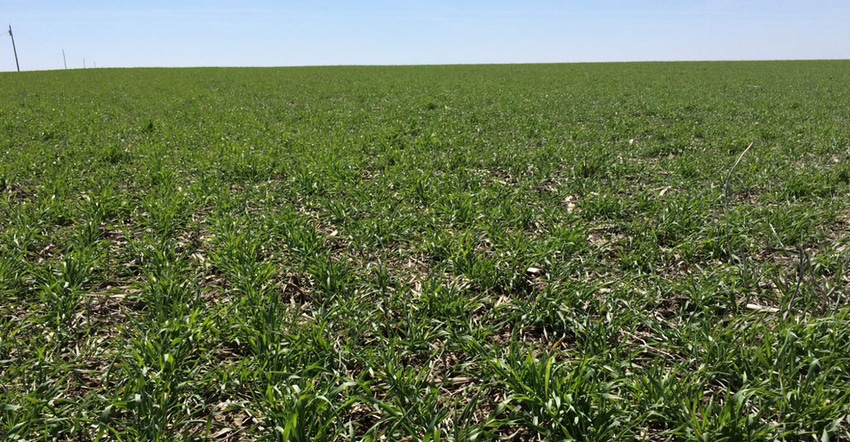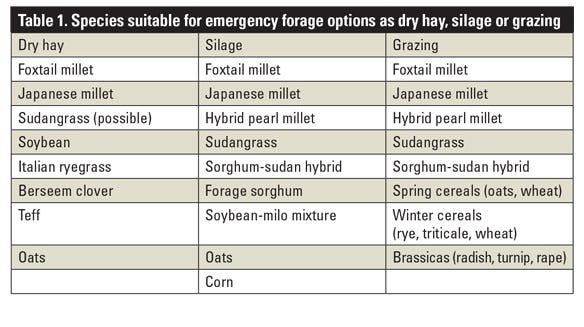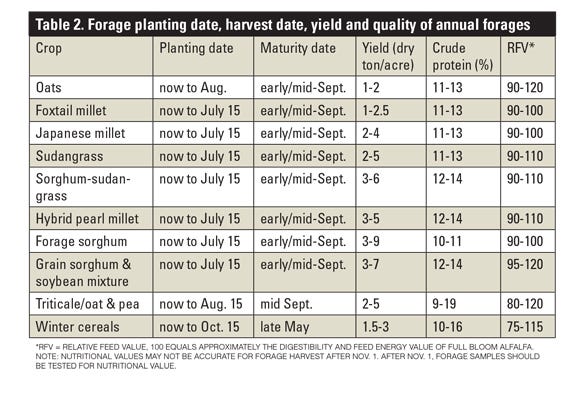June 6, 2019

Decisions surrounding delayed planting due to flooded fields and rain delays this spring are complicated. There’s a lot to consider when deciding whether to go ahead and plant corn or soybeans, and gamble on how much the yield will be reduced. Or should you take the prevented planting option offered by crop insurance?
Your delayed planting and prevented planting decisions should involve consulting with your crop insurance provider. Iowa State University’s Ag Decision Maker discusses the insurance provision implications on its website.
Other articles address late corn planting options and late soybean planting options. “These articles discuss late-planted yield potential,” notes ISU Extension cropping systems agronomist Mark Licht. “Each choice has practical and economic implications. You need to approach this decision with caution and armed with good information.”
Emergency forage
If you decide to take the prevented planting option, it is highly recommended to plant a cover crop or an emergency forage crop rather than letting the field be fallow through the summer. However, under the prevented planting provisions, a cover crop or emergency forage crop cannot be grazed or harvested for forage until after Nov. 1. Also, the rules state that it can’t ever be harvested for grain without a reduction to the prevented planting coverage payment. “Again, it’s important to discuss this with your crop insurance agent,” Licht says.
With the help and input from his ISU field agronomist colleagues, Licht has put together the following information on forage crop alternatives for fields where farmers are taking the prevented planting crop insurance option.
Annual forage crop alternatives
Three major concerns arise in selecting a forage option:
Some options simply provide a cover crop.
Some can provide major forage production during summer or early fall at the expense to the prevented planting payment.
Some can provide a certain aspect of grazing or harvested forage after Nov. 1.
Thus, the strategy of what to plant and when depends on the final objective. When considering crops for an annual forage, practical options include grazing, dry hay, stock piling and silage.
Various crops may work as forage options; however, those listed in Table 1 would be the most practical, predictable and economical. Seed supplies of some of these forage crops may be low due to increased demand. As you consider these options, check on seed availability.

When considering forage species for prevented planting acres, review carefully what herbicides were used earlier in the spring in preparation for corn or soybean planting. Additionally, some herbicides from the prior growing season might have plant-back restrictions that need to be considered. Read and know restrictions on herbicides that you have used.
Forage options
Forage species worth considering:
Foxtail millet. Also called German, Siberian or hay millet, this summer annual grass used as a harvested or grazed forage. Plant through mid-July; it’s usable in about 50 days. You’ll get one summer’s growth (vegetative 1 to 2 feet and with seed head 2 to 3 feet). Considered best of the “millets” for an emergency hay crop, but can become a weedy grass if allowed to produce mature seed. It will terminate with fall frost, minimizing grazing potential after Nov. 1.
Japanese millet. This summer annual grass is a relatively coarse (stemmy) forage, and used as fresh-cut forage, hay, silage or pasture. Plant through mid-July; it’s usable in about 50 days. Very little regrowth if first growth is allowed to reach maturity. If cut at vegetative growth stage, regrowth yields are more likely. Leave a 5- to 6-inch stubble height to maximize regrowth. This forage species is closely related to the grassy weed barnyard grass, so avoid allowing seed formation. It will terminate with fall frost, minimizing grazing potential after Nov. 1.
Hybrid pearl millet. The multiple-cut, warm-season annual is used for fresh-cut forage, pasture (rotational grazing recommended) or silage. It resembles sorghum-sudangrass hybrids in plant structure. It’s usable in about 50 days. Leave a 6-inch stubble height to maximize regrowth. Somewhat slower regrowth than sorghum-sudangrass hybrids; its production is poor in cool summer seasons. It has no risk of Prussic acid poisoning, and will terminate with fall frost, minimizing grazing potential after Nov. 1.
The annual millets described above are of particular interest. They are warm-season crops and perform best in warm, sunny growing seasons. They have not performed up to expectation during cool, cloudy summers.
Sudangrass. This a multiple-cut, summer annual is used for fresh-cut forage, pasture (rotation grazing recommended), or silage. Difficult to dry thoroughly for hay, varieties vary in height and leafiness. Plant through early-July. The first growth is usable in about 50 days. At this late planting date, you may get a second harvest or grazing. Leave a 6-inch stubble height to maximize regrowth.
Prussic acid poisoning risk is minimal, but avoid pasturing if it is severely drought-stressed or very short (less than 18 inches). Use caution if grazing soon after frost. Will terminate with fall frost, minimizing grazing potential after Nov. 1.
Hybrid sorghum-sudangrass. A multiple-cut, summer annual, it used for fresh-cut forage, pasture (rotational grazing recommended) or silage. Varieties vary greatly in height, leafiness and grain yield, depending on the parent lines making up the hybrid. Plant through early-July. The first growth is usable in about 50 days; regrowth is from tillers. At this late planting date, you may get a second harvest or grazing. Leave a 6- to 8-inch stubble height to maximize regrowth.
There is prussic acid poisoning risk if plants or tillers are grazed or green-fed at a short height (less than 24 inches) or during severe drought. Also, use caution if grazing soon after frost.
Sudangrass and sorghum-sudangrass hybrids are better adapted than most species to drought, high temperature and low soil pH than corn, but will yield less in seasons with cool August and September temperatures. Sudangrass and sorghum-sudangrass hybrids should be harvested at 2 to 3 feet (two to three cuttings per season).
Harvesting at later maturity may increase yield but will result in lower forage quality. It will terminate with fall frost, minimizing grazing potential after Nov. 1.
Grain sorghum, soybean mixture. This mix can be planted through early summer. It has a harvestable window of about 70 to 110 days. Requires good fertilization for production. Generally, target harvest at late vegetative or very early head stage of sorghum.
Italian ryegrass. This crop can be planted through August and would provide some forage for grazing in November. There would likely be a hard freeze before then, but it would still provide available grazing forage.
Berseem clover. This annual warm-season legume grows well in a wet summer. It requires a specific rhizobium for nodulation. Like alfalfa, first growth is usable in about 60 to 70 days. The seed is more expensive than other species. It is terminated with a killing frost, therefore, forage quality and quantity available after Nov. 1 can vary significantly.
Teff. The warm-season annual grass is a fine-stemmed, leafy forage of good quality, but it has had questionable success in Iowa. Drydown for hay is difficult. A shallow root system makes it problematic for grazing. Good, rapid regrowth following harvest depends on leaving a stubble height of at least 4 to 5 inches. It will terminate with fall frost, minimizing grazing potential after Nov. 1.
Spring cereals. Crops such as oats, wheat, barley can be planted in June or July as a cover crop and can be grazed at about any time. It will likely head at a short height and shattering will occur. It can be cut and stored as dry hay or silage from late-vegetative through early milk stage. At dough stage, the stems decrease feeding value greatly. Oats is usually the cheapest option.
Winter cereals. Rye, wheat and triticale can be planted as early as June or July. They will remain vegetative through the season, only reaching a height of about 1 foot. There is no stem production until it goes through the winter. Clipping winter rye in late summer is advised to ensure overwintering success. Winter triticale would be expected to respond similarly, whereas winter wheat would likely experience winterkill. They are suitable for grazing and forage.
Winter cereals planted this year and harvested in spring can be ensiled and make good feed for young stock and even mature animals. When harvesting for silage, moisture content is critical. The target is similar to corn silage at 35% dry matter or 65% moisture. These forages tend to dry down fast, so it is better to plan harvest when final dry matter is around 35%. Because of the structure of the stem, high packing density is essential for good fermentation. To achieve high density, harvest at boot stage and chop at a half inch or shorter. The use of silage inoculants is highly recommended for this type of forage.

Editor’s note: This article has been adapted from two previous ICM articles written by retired ISU Extension forage agronomist Steve Barnhart. They are Prevented Planting and Cover Crop Considerations, June 2013, and Forage and Cover Crop Considerations for Delayed Planting and Flooded Sites, June 2008.
About the Author(s)
You May Also Like






